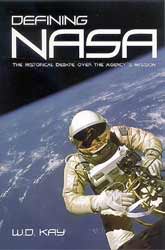
Most people know that NASA is the agency of the United States that pursues space activities. Though sounding simple enough, this statement can lead to pitfalls just like in moving mountains. First off, what, or more precisely, where exactly does space begin and end? Further, what are the space activities and equipment for which NASA is responsible? Should this include all launch vehicles, launch pads, and space stations? Are only they responsible for earth observation, travelling to other planets and understanding the meaning of life? As Kay succinctly points out, there is a fine and constantly changing line that delegates duties to NASA, other parties, or to no one at all.
In support of the discussion of space policy, Kay begins by defining elements of his craft. Within his analytical framework, a government policy includes definition and information (e.g. what is a mountain), ownership (e.g. who’s responsible for the mountain) and goals (e.g. move what to where). In developing this framework he then continually refers back to it while discussing the policies of NASA from inception to about the year 2000.
Kay begins with assessing Eisenhower’s interests. His considered space solely as another theatre of warfare. He raises the subterfuge regarding the use of the International Geophysical Year as evidence. Also he draws on the administration’s apparent lack of interest in Soviet progress with Sputnik and Gagarin. Kay then argues that public perception, massage and crafted by political leaders, turned this situation into a nation security issue. With the horrific spectre of space based weapons breathing down their necks, people’s pocket books opened and the ‘space race’ arose. Further, Kay demonstrates how space achievements were even a noticeable gauge in the opinions of third world countries. That is, by being aligned with national security, space activities could also be justified as a means of foreign diplomacy.
This big change in space policy, as Kay notes, came about due to outside events, principally the advances of the Soviets. The next change occurred because the space program met its objectives. National and world opinion considered the US to have a better space program, hence the space race was won and national security no longer drove space policy. Kay argues that this began in 1965 and supports this with discussions about budgets, appropriations and directives from the political leaders. The consequence was that NASA became a fully operative program without a policy.
Here Kay demonstrates the main challenges of crafting policy in a democracy. In returning to his analytical framework, he shows that programs bereft of policy become unfocused and are primarily subject to political and budgetary forces. Because of this new direction, the space shuttle was born as it was to dramatically lower the cost to access space. Next, the space station was born due to political issues. Then, Kay leaves the reader hanging as he quite rightly points out that NASA still is without an effective policy.
There is nothing new in Kay’s historical view of space activities. Its values is in the novel assessment of space policy purely from a political science perspective. Kay’s writing is very clear and his arguments are well supported with reason and references. There may be too many references for some as it, together with the indices and table of contents, add up to almost a third of the book. Still, the text appears as a very open, honest and accurate assessment of the United State’s space policy through the previous fifty years.
The space agency NASA has a carefully constructed image of being an expert on space. In so doing they expect that anyone interested in space would come to their door. However as shown in W.D. Kay’s book, Defining NASA – The Historical Debate Over the Agency’s Mission, this is not sufficient. As he writes, NASA, like any government program, must continually have a viable, effective policy to be as effective a program as it was in its early years.
Read more reviews online, or purchase a copy from Amazon.com.
Review by Mark Mortimer.
